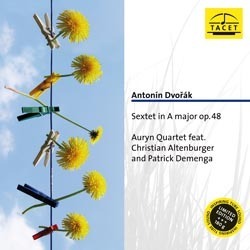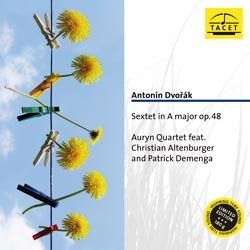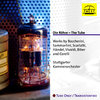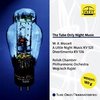Tacet - L196 - 180 Gram Virgin Vinyl - AAA 100% Analogue
Limited Edition - Pure Analogue Audiophile Mastering - Pressed at Pallas Germany
The Absolute Sound Super Disc List TAS Harry Pearson Super LP List
TAS Rated 4/5 Music, 4/5 Sonics in the October 2011 Issue of The Absolute Sound
If the Mendelssohn and Rossini works are of the warhorse variety, performances of Dvořák’s sextet for strings are about as common as a copy of Donald Trump’s tax return. So, if you’re not familiar with the sextet, join the club! However, it’s Dvořák, for goodness sake, so it shouldn’t be surprising that the sextet in A is a winner, given his remarkable track record of composing beautiful and interesting music. Luckily for us, Tacet decided to record it as only they can, with valve microphones and their renowned recording gear, combined with the secret sauce of years of experience. Even if you’re not a Dvořák or chamber music devotee, I think you’ll be happy you sprung for this disc. Audiophile
No conductor, no semiconductor--I beg your pardon?
Q: Just what's going on here? No conductor? No transistors (=semi-conductor)?
A: New recordings and new old techniques.
About 50 years ago the transistor was invented - and it changed our world! No computer, no piece of household equipment can be imagined without it. But what about audio technique? We were curious. Did something get lost? And if so, what? - a LP without transistors? Is that feasible?
Antonín Dvořák
Sextet in A major op. 48
Auryn Quartet feat.
Christian Altenburger
and Patrick Demenga
Inspiring Tube Sound
Unusually, Antonín Dvorák’s String Sextet op. 48 was recorded using ten modern microphones from TACET’s collection of tube microphones, and not a single historical one. However, these new microphones have a great deal in common with the 'old' ones, as a glance at the history of the manufacturer shows ... As a matter of fact, the sound of the Microtech UM 92.1 S is somewhat similar to Andreas Spreer’s favourite microphone, the historical Neumann M49 produced by the Berlin company Neumann; it conveys a warm, silky yet always transparent sound. The enjoyment found in this recording is, however, not solely due to the microphones but (once again) primarily to the musicians. The Auryn Quartet, augmented by Christian Altenburger on the viola and Patrick Demenga on the cello, bring out all the intricate details, which are to be found in the score of this harmonic and melodic masterpiece, and pamper us with a true feast for the ears..
The Auryn Quartet, augmented by Christian Altenburger on the viola and Patrick Demenga on the cello, bring out all the intricate details, which are to be found in the score of this harmonic and melodic masterpiece, and pamper us with a true feast for the ears.
"Great sextets are few and far between, even in the 19th century, and their relative scarcity explains their infrequency of performance. The presence of another of Dvorák's delightful variation finales unifies the program, but there are many more riches to be found in this piece, including a second-movement Dumka and a scherzo that shares a theme with the first Slavonic Dance. Once again the performance is all that anyone could want: ripely romantic and lush, but also rhythmically incisive and full of color. The Dumka in particular has a wholly idiomatic, Slavic intensity. Toss in state-of-the-art sonics and you have a stunning release all around." - David Hurwitz, ClassicsToday.com
Inspiring Tube Sound:
The difference between the tube microphone M 92.1 and the UM 92.1 S consists merely in the directional characteristics. The M 92.1 S preferably records the sound from the front ("cardioid"), the UM 92.1 S can be switched between "omnidirectional", "cardioid" and "figure of eight" (more on this on TACET 17: The Microphone and TACET 49: The Microphone, Vol. 2). The recording of the Sextet of Antonin Dvorak was made, threfore, by means of 10 modern microphones (6 Microtech M 92.1 S, 4 Microtech UM 92.1 S) from the TACET tube microphone collection, without a historical one among them, as is otherwise customary.
Recording in November 2010 in Honrath, Germany, by Andreas Spreer.
Inspiring Tube Sound:
What is it that makes "tube sound" what it is? The advantages of tubes over transistors are difficult to describe in technical terms. Perhaps the reference to the higher and different type of distortion with tube amplifiers is most applicable, although "distortion" has a rather negative meaning: the more distortion, the worse it is. So this can't be entirely right. Besides, the distortions of these microphones of 1947 are much too slight to be really noticeable. The recording of the Partitas of Johann Sebastian Bach with Florin Paul is, for me, although meanwhile almost 23 years old, still the best example in our TACET catalogue of the special quality of tube microphones. The two U 47 microphones by Neumann made their contribution.
For the LP, however, (except for rare exceptions, justified for musical reasons) the signal is even stored on a tube tape recorder and then mastered with valve equipment, so that one would be right in saying that for the entire production not a single transistor was used.
We have always been especially pleased to receive so much feedback about our Tube Only productions. This motivates us even more to keep working with this technology and rescue it from oblivion. People have told us that the music sounds warmer, without losing any of its TACET brilliance. The timbres glow more. We have also heard that people have the impression of a more homogeneous sound, whatever that is meant to be. So let everyone listen to their own hearts and to the Tube Only recordings and feel something special! Even the sheer joy of this slightly nostalgic outstanding technology can be reason enough to like these productions. Yet what would it all be without the wonderful work of the artists!
Musicians:
Matthias Lingenfelder, Violin I
Jens Oppermann, Violin II
Stewart Eaton, Viola I
Christian Altenburger, Viola II
Patrick Demenga, Cello I
Andreas Arndt, Cello II
Selections:
Antonin Dvorak (1841-1904)
Sextet for 2 violins, 2 violas, and 2 cellos op. 48 in A major
Side A:
1. Allegro moderato
2. Dumka (Elegie). Poco allegretto
Side B:
3. Furiant. Presto
4. Finale. Tema con variazioni. Allegretto grazioso, quasi andantino













